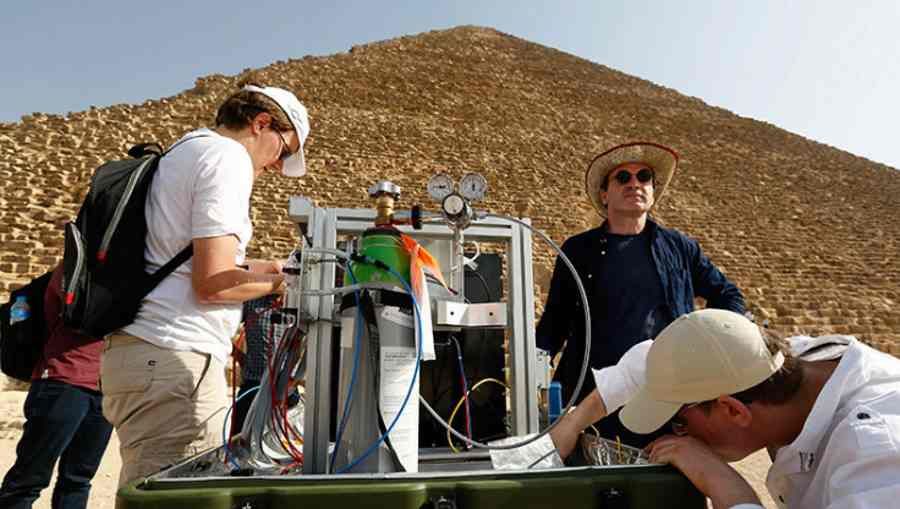Muons – particles that help explore the impenetrable
Thanks to muons, last year archaeologists made an amazing discovery of a previously unknown chamber in the Great Pyramid. Thanks to a technique that uses scanning streams of muonsow, scientists have confirmed the presence of a large, empty space in the pyramid of Cheops. Volcanologists and nuclear engineers are also finding new uses for this technique called muonography (muon radiography). This is a new, specialized technique, whichora comes from the world of high-energy physics.
– The discovery in the pyramids last year gave a real „kick” mionography – said David Mahon, a physicist at the University of Glasgow, cooł organizer of an international meeting called Cosmic-ray Muography, whichore last week held in Newport Pagnell in the UK. The technique makes it possible to probe the insides of dense structures, and already there have been companies looking to commercialize the technology.
Muons are everywhere
Muons are negatively charged unstable elementary particles belonging to the lepton categoryow. They are related to electrons – have the same properties, but more than 200 times the mass of the. They are created when high-energy particles called cosmic rays collide with atomic nucleioin gasoin the earth’s atmosphere. This is the so-called. wtoOther cosmic rays. It is from these collisions that muons are formed. Their most interesting feature is that they can penetrate matter to some extent.
Podrosion bombard the Earth from all sides, traveling at close to the speed of light. Each area of our planet about the size of a hand is hit by about one muon per second. The particles can penetrate hundreds of metersoin solid material before they are absorbed.
– Their ubiquity and penetrating power make muons ideal for imaging large, dense objectsoIn without damaging them – explained Cristina Cârlogan from the Laboratory of Physics in Clermont-Ferrand, France. The denser the material, the more energy it absorbs from particles, so physicists can track how often muons o roThey reach the detector at different energiesoin placed woko³ target. With this, a 3D profile of the interior of a particular structure can be created.
Physicists have been experimenting with the technique since the 1950s. In the 1970s. They have used it to scan the pyramids, but without effectow. At the time, there was no suitable technology. Only relatively recently have ways been developed to more accurately track the paths of these charged particles. Thanks to the research of physicistow muon detectorsow are smaller, but notably more sensitive.
Volcanoes have become a popular target for this technique. All this thanks to the pioneering work of scientistsoin Japan. – Channel mappingow lavas, whichore absorb less energy from muonoin than the surrounding dense rock, perhaps one day pomoc in predicting volcanic eruptionsow – admitted Cârlogan.
This year, researchers are trying on imaging the interior of Vesuvius. – When combined with more conventional geophysical methods, these images can pomoc volcanologists to deduce ktore parts fly into the air first during an eruption – said Raffaello D'Alessandro, a particle physicist at the University of Florence. He is a member of the MIR Radiography of Vesuvius project, known as Muraves.
Smaller detectors are used in archaeology. Mapping the pyramids is this spectacular research. But the technique has been used roalso in other places. Archaeologists have used it to create maps of tunnels under Naples, in its oldest parts. Teamoł D'Alessandro will explore using the detectoroin the muon cathedral in Florence, where cracks were spotted in the walls. This will make it possible to assess the condition of the building.
Commercialization of muonsow
A number of commercial applications for muonography were presented during the conference. Someore of them use a slightly different technique, whichora tracks howob muons change direction when they strike material. By placing detectors on both sides of the probki, physicists can reconstruct the particle’s trajectory. And since the deflection angle correlates with the density of the substance in which theor by the impact of the muon, studying these paths can helpoc in creating a density map of the material under study.
This allows engineers to detect even stray uranium fragments in radioactive waste containers, even if they are encased in concrete or steel.
– Muons are the only way to get information about what is deep inside the structure – emphasized Mahon. Its company – Lynkeos Technology, wkrotce will begin imaging studies of wasteoin nuclear.
Similar technology allows imaging of reactor interiorsow nuclear. Physicists at Los Alamos National Laboratory in the US are working on it. Anyway, muon scanning was used to image the inside of the Fukushima reactor after the 2011 disaster.
Israeli company Lingacom, based in Tel Aviv, is studying the roalso the possibility of using this type of imaging during safety inspections, e.g. at airports or border crossings. Companies in the mining sector roare also interested in the technology. It can be used to track leaks in transmission pipelines or to search for valuable mineralsow.
Despite the growing applications for this technology, it is often treated with a pinch of salt. – When at least moTie geologists that we have muon technology, they ask: What are muons?. They are fascinated, but also a little distrustful – admitted Giulio Saracino, a physicist at the University of Naples.

